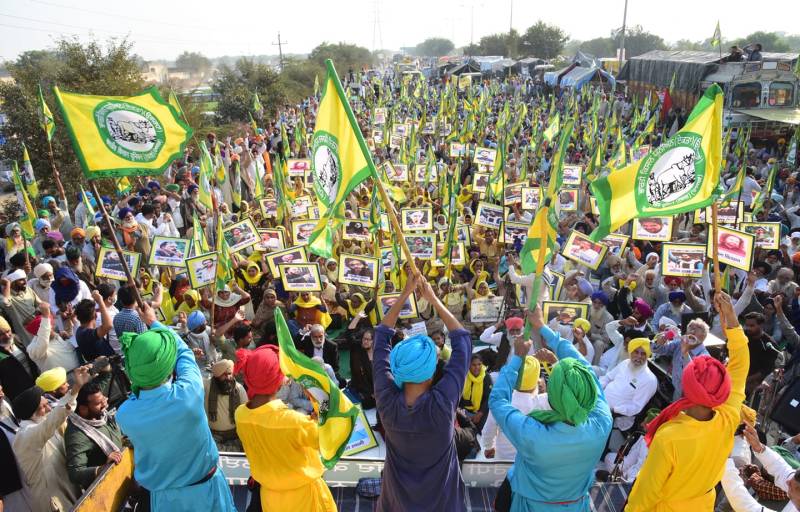
In 2021, India's Prime Minister Narendra Modi had to capitulate in the face of year-long protests from the nation’s farmers, when he agreed to repeal three controversial farm laws. These laws, aimed at modernizing the agriculture sector by incentivizing industrialized agriculture, were seen as a potential threat to the livelihoods of the farming community, which directly or indirectly employs over 40% of India's 1.4 billion people. The repeal seemed to have pacified the farmers, who are primarily concentrated in the breadbasket state of Punjab.
However, just a little over two years later, a renewed wave of discontent has swept through the politically sensitive north of the world’s most populous country.
The country’s farmers are out protesting again, now advocating for legal guarantees to ensure a minimum purchase price for all crops, and debt waivers, just months before a general election scheduled for May.
Nearly 20,000 farmers, mounted on their tractors or trucks, are making their way towards New Delhi, the federal capital, in an attempt to persuade the government to meet their demands. The protestors include farmers associated with the Kisan Mazdoor Morcha (KMM), the Samyukta Kisan Morcha (SKM), the Kisan Mazdoor Sangharsh Committee and over 100 other farmers’ unions.
The protesting farmers’ demands include guarantees for a minimum support price (MSP) for agricultural produce, implementation of the MS Swaminathan Commission's recommendations, pensions for farmers and farm laborers, farm debt waivers, reinstatement of the Land Acquisition Act, 2013, withdrawal from the World Trade Organization, and compensation for families of farmers who died during previous protests between 2020 and 2021.
Authorities have responded to the protests by barricading highways with cement blocks, metal containers, and barbed wire to prevent the demonstrators from entering the city. Talks between the farmers and the government have hit an impasse, and the situation remains tense.
While the current protests are centered in Punjab, the farmers' grievances resonate beyond the state. The core complaint revolves around falling incomes, as farmers believe that the Modi government, along with the ruling Bharatiya Janata Party (BJP), has not done enough to support their community and uplift living standards. This sentiment is particularly strong in India's vast rural hinterland, where many feel neglected in comparison to their urban counterparts.
Four rounds of negotiations have taken place between the central government and farmers’ representatives, but no resolution is in sight. On February 18, after the latest meeting between Ministers Arjun Munda, Piyush Goyal, Nityanand Rai and farmer leaders Jagjit Singh Dallewal and Sarwan Singh Pandher, the government offered to procure five crops on MSP by entering into a contract for five years. The protesting farmers, however, rejected the government’s offer.
How has the government responded?
The ongoing protests, which began in Punjab with hundreds of farmers intending to march to the capital, Delhi, was met with resistance from police and paramilitary forces at the Shambhu border, approximately 200 km from Delhi.
Concrete barricades, barbed wire, and rows of metal spikes were set up to deter the farmers' caravan of tractors and trucks. Clashes ensued, with reports of cane charges and tear gas grenades dropped by drones, leading to injuries on both sides and at least one reported death.
India's beleaguered opposition, desperately seeking a narrative to counter Modi's image as a nationalist strongman, have thrown their support behind the protesting farmers. Leaders like Sukhpal Khaira, a senior member of the Congress party in Punjab, emphasized that while they may not have defeated Modi, the disruption caused by the protests serves a valid purpose.
Farmers have transformed their tractors and trailers into makeshift homes at the protest sites, setting up community kitchens supplied with essentials from nearby villages. The opposition, particularly the Congress party, has supported the farmers financially, with members pooling resources to purchase medicine and gas masks in anticipation of potential clashes with security forces.
Farmers and opposition leaders anticipate that the protest will not remain confined to Punjab, mirroring the trajectory of the 2020-21 protests. Many observers believe that an intensification of the protest will diminish Modi's popularity and highlight the government’s apathy towards addressing farmers' concerns.
Despite several rounds of talks between the government and farmers, a resolution remains elusive. Shehzad Poonawalla, a national spokesperson for the BJP, asserts that the government is committed to addressing farmers' concerns and helping the poor.
The economic plight of the protesting farmers
Experts suggest that as India's economy has grown, the government's economic policymaking has failed to transition the workforce away from farm labor, which has led to falling levels of average income. Observers also suggest that while the ongoing protest might not significantly impact the BJP in the upcoming elections, Modi is likely to face a serious challenge in his next term over grievances from rural constituencies.
The protesting farmers argue that Modi has not fulfilled a promise made in 2016 to double their incomes by 2022. Instead, a series of export restrictions on essential crops like wheat, sugar, onion, and most rice grades, aimed at controlling consumer prices, have limited their access to global markets and higher prices for their produce.
Indian farmers’ yields have also been severely impacted by the climate crisis. Increased frequency of extreme weather events and a falling water table in the breadbasket states of Punjab and Haryana has lowered yields for farmers and pushed many towards cyclical debt.
The disparity between urban and rural India has widened during the Modi years, and this inequality is poised to exacerbate if the government fails to address the crisis in the agriculture sector.
The agriculture sector's significance is not just economic; it also plays a crucial role in India's social fabric. Agriculture makes up approximately 15% of India's $3.7 trillion economy, and in the last five years, the farm sector's growth has lagged behind manufacturing and services. Government-fixed minimum purchase prices for key crops like rice and wheat have seen only relatively modest increases during Modi's ten-year rule.
Additionally, farm lending has tripled in the last nine years, reaching nearly 20 trillion rupees, according to the central bank. More than half of India's 93 million farm households are burdened with significant debt, with an average loan of 74,121 rupees per household, per government estimates. The pace of growth in real rural wages has been sluggish, contrasting with the substantial increase in average salaries in urban areas.
ICRA, the Indian arm of the rating agency Moody's, reported that the growth in real rural wages was around 1% in 2023, after contracting nearly 3% in the previous two years. In contrast, average urban salaries have been rising at almost 10% annually.
Farmers gearing up to intensify protests
Meanwhile, the farmers are gearing up for more agitation. The protest is set to intensify further on March 6, with farmers from Punjab and Haryana traveling to Delhi on buses and trains. A nationwide rail blockade is being planned for March 10 to amplify the farmers’ demands and draw attention to the broader support for the agitation.
The Indian government has faced harsh criticism for its handling of the protests. The authorities' use of drones to drop tear gas shells on protesters has raised eyebrows and fueled concerns about privacy and the use of technology for crowd control. While this incident is not the first time that drones have been used in this manner, it highlights the BJP’s increasing reliance on technology for policing and surveillance in India.
The Indian authorities have also resorted to using pellet guns against farmers. These are the same iron pellets that are routinely deployed by the Indian military in occupied Kashmir and routinely cause life-altering injuries to their victims, including blindness.
Human Rights Watch has accused the government of using threats, excessive force, and internet shutdowns to suppress the farmers’ protests. One tragic incident during the protests heightened tensions when a 24-year-old farmer, Shubhkaran Singh, died on February 21 from a head injury sustained allegedly during police action at the border of Punjab and Haryana.
The government's attempts to control the narrative by suggesting that only a couple of farmer unions are leading the protests faces stiff opposition from the farmers' groups.
The protests have also been wracked by the spread of online misinformation, from accounts both supporting and decrying the protests. The farmers and their supporters have been met with derogatory statements labelling them as traitors and "anti-national."
Even X (formerly known as Twitter) has joined the fray, by claiming that it was asked by the Indian government to remove accounts linked to the farmers’ protests, but that it disagrees with the government’s actions.
“We will withhold these accounts and posts in India alone; however, we disagree with these actions and maintain that freedom of expression should extend to these posts,” X’s Global Government Affairs team said in a post.
